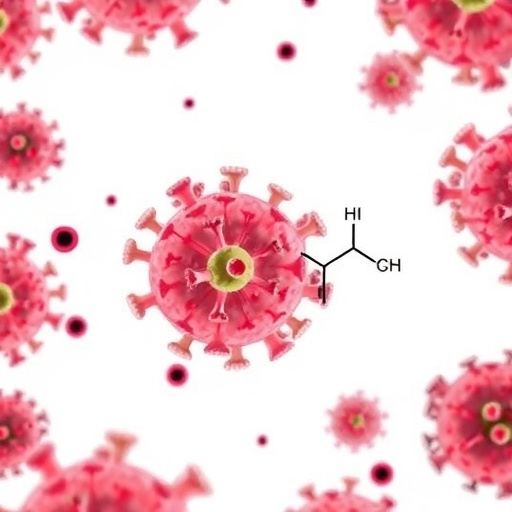In the ongoing battle against infectious diseases, influenza A virus (IAV) remains one of the most daunting adversaries due to its high contagiousness and remarkable ability to evolve rapidly. Recent research published in Acta Pharmaceutica Sinica B introduces an innovative therapeutic strategy employing a novel chemical entity derived from oleanolic acid, a naturally occurring pentacyclic triterpenoid. This breakthrough compound, named A5, is a C-3-substituted oleanolic acid benzyl amide derivative that exhibits unprecedented antiviral efficacy against IAV by targeting a critical protein–protein interaction essential for viral replication.
Influenza A virus is notorious not only for seasonal outbreaks but also for its potential to spark global pandemics. One of the greatest challenges in managing influenza infections is the emergence of drug-resistant viral strains, which often render conventional therapies ineffective. In this context, the viral RNA polymerase complex—particularly the interaction between its PA and PB1 subunits—serves as a vital target for developing novel antiviral agents. The polymerase complex orchestrates viral RNA synthesis, and its disruption halts the production of new viral genomes, effectively curtailing virus replication.
The study details the biochemical characterization of A5, revealing its potent inhibition of the interaction between the C-terminal domain of the PA subunit (PA_C) and the N-terminal domain of PB1 (PB1_N). The compound achieves this with an impressive half-maximal inhibitory concentration (IC_50) of 0.96 ± 0.21 μmol/L, highlighting its high affinity and specificity for the PA_C target site. By binding to this highly conserved domain, A5 blocks the formation of the polymerase complex, a step that is indispensable for the influenza virus life cycle. This mechanism distinguishes A5 from traditional neuraminidase inhibitors, offering a complementary approach to antiviral therapy.
Beyond laboratory-adapted strains, A5 demonstrates broad-spectrum antiviral activity against a range of clinically isolated IAV variants, including multidrug-resistant strains that have become a critical public health concern. The effective concentration (EC_50) values of A5 span from 0.60 to 1.83 μmol/L across these diverse viral backgrounds, underscoring both its potency and versatility. Such efficacy suggests that A5 could serve as a cornerstone in future antiviral regimens, especially for cases where existing drugs fail due to resistance.
One of the most compelling aspects of A5’s antiviral strategy is its synergistic effect with oseltamivir, a frontline neuraminidase inhibitor. Co-treatment experiments in cellular models reveal that the combination significantly amplifies viral suppression compared to single-agent use. This synergy is also validated in vivo, where murine models receiving both A5 and oseltamivir exhibit markedly improved survival rates and decreased viral titers in lung tissues. This combinatorial approach not only enhances therapeutic efficacy but may also delay or prevent the development of resistance by exerting multifaceted pressure on the virus.
Apart from its direct antiviral effects, A5 displays an intriguing immunomodulatory capacity by targeting host macrophage responses. Influenza infection often triggers excessive immune activation, leading to cytokine storms that exacerbate tissue damage and disease severity. The research shows that A5 effectively inhibits virus-induced activation of Toll-like receptor 4 (TLR4), a key player in innate immune signaling. By attenuating TLR4–MyD88–NF-κB signaling pathways, A5 reduces pro-inflammatory cytokine release, thereby mitigating the potentially deleterious effects of hyperinflammation during infection.
This dual action of A5—antiviral activity coupled with dampening of harmful inflammation—positions it as a promising candidate for comprehensive influenza treatment. The compound shields macrophages from inflammatory injuries typically induced by the virus, preserving innate immune function while preventing immune-mediated damage. Such balanced immunomodulation is critical in managing severe influenza cases, especially those involving cytokine storm syndromes.
Importantly, the pharmacokinetics and safety profile of A5 were evaluated through dose-dependent studies in mice. The compound exhibited a favorable therapeutic window, effectively reducing viral loads without evident toxicity. Histopathological analyses of lung tissue confirmed decreased inflammation and reduced cellular infiltrates in A5-treated animals, correlating with improved respiratory function and survival outcomes.
The molecular design of A5 draws inspiration from the structural versatility of oleanolic acid, a compound derived from natural sources with a long history of medicinal use. By chemically modifying the C-3 position to introduce a benzyl amide moiety, researchers enhanced target specificity and bioactivity against IAV polymerase. This rational drug design exemplifies how modifications of natural product scaffolds can yield potent synthetic analogs capable of addressing unmet medical needs.
Further investigations into the binding dynamics of A5 to the PA_C domain employed biophysical techniques such as surface plasmon resonance and molecular docking, validating the compound’s stable and high-affinity interaction with its target. These findings reinforce the feasibility of developing small-molecule inhibitors aimed at disrupting critical viral protein–protein interactions, a strategy that holds promise for other viral pathogens as well.
The discovery of A5 heralds a new chapter in antiviral drug development, emphasizing the importance of targeting viral replication machinery beyond conventional enzymatic active sites. By impeding the assembly of functional polymerase complexes and simultaneously curtailing excessive immune activation, A5 embodies a multifaceted therapeutic approach that could significantly improve influenza management worldwide.
As influenza viruses continue to evolve and challenge global health systems, the arrival of novel agents like A5 offers hope for more effective and sustainable treatments. Future clinical trials and further optimization of A5 derivatives will determine the translational potential of this discovery, which already marks a significant scientific advancement in combating one of humanity’s most persistent viral foes.
Subject of Research: Influenza A virus, antiviral drug development, RNA polymerase inhibition, immunomodulation
Article Title: A novel C-3-substituted oleanolic acid benzyl amide derivative exhibits therapeutic potential against influenza A by targeting PA–PB1 interactions and modulating host macrophage inflammation
News Publication Date: 2025
Web References:
Journal: Acta Pharmaceutica Sinica B
DOI: 10.1016/j.apsb.2025.05.031
Keywords: Influenza A virus, RNA polymerase, protein–protein interaction, pentacyclic triterpenoids, oleanolic acid amide derivatives, drug-resistant strains, inflammation, Toll-like receptor 4
Tags: antiviral efficacy against influenza Abiochemical characterization of antiviral compoundsC-3-substituted oleanolic aciddrug-resistant influenza strainsglobal pandemic potential of influenza Ainfluenza treatment research advancementsinfluenza virus replication mechanismsinnovative chemical entities in virologymacrophage inflammation regulationnovel therapeutic strategies for influenzaPA-PB1 protein interaction inhibitionpentacyclic triterpenoid derivatives





